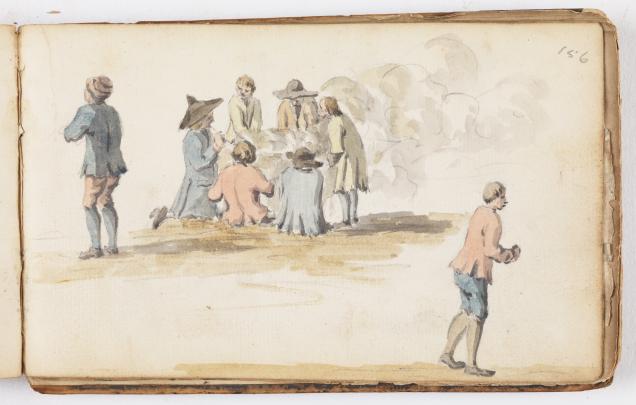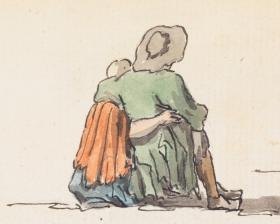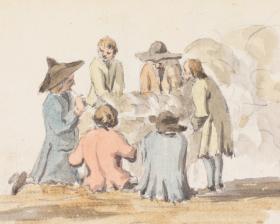Celebrations
Students explore how special events were celebrated in the early colony.

Celebrations
Celebrations in the early colony were fairly rare. The birthdays of the British royal family were celebrated, along with Christmas and weddings.
The King’s Birthday was always celebrated by the colony of NSW. On 4 June 1788, the Governor and officers, including Surgeon George Worgan, had a special meal of:
Mutton. Pork Ducks, Fowls, Fish, Kanguroo, Sallads, Pies & preserved Fruits, The Potables consisted of Port, Lisbon, Madeira, Teneriffe and good old English Porter, these went merrily round in Bumpers.
Define the word bumpers.
The convicts had a special treat too in addition to their regular small meal of salted beef, flour, peas, butter and rice.
Read about it in Surgeon George Worgan’s journal.
Each Convict was allowed a Pint of Grog, and all Work, was suspended for the Day.
Define the word grog.
Compare the meals.
After eating, bonfires that had been prepared by convicts were lit for everyone to enjoy including the Governor, officers, officials, sailors and the convicts.
Read this quote from Surgeon George Worgan’s journal:
[We] walked out to visit the Bonfires, The Fuel of One of Which, a number of Convicts had been two Days collecting…it was really a noble Sight, it was piled up for several Yards high round a large Tree; Here, the Convicts assembled, singing and Huzzaing…
Define the word huzza.
Now everyone in the class – do a huzza!
But the next day:
it was found that while many of the Convicts were rejoicing at the Bonfire, there were others practising their old Custom of Thieving, and many of the Officer's Tents & Huts had been robbed.
Oh dear! Stealing is perhaps not the best way to spend your idle hours!
Marriages between convicts were encouraged by Governor Artur Phillip. There were 70 convict marriages in the first year. A convict wedding was celebrated in May 1788 between Anthony Rope and Elizabeth Pulley.
Look at this image of a man and his wife that we can imagine might have been Anthony and Elizabeth.

Read Surgeon George Worgan’s record of what he heard:
About a Week ago, a fine.. Goat… was found Dead… and one of the Men was to be married the next Day, they took the Liberty of cutting some of the Meat off, to make a Pie for the Wedding-Dinner.
Answer this question:
- What word do we use today instead of dinner to explain the meal with family and friends during the wedding reception? Research why we call it that.
Convicts did not usually celebrate their wedding with a special pie at a Wedding-Dinner as they would have only had food rations of salted beef or pork, pease, rice, flour and butter. The pie’s pastry top would have been made using flour and butter rations. Another mention of pies in the colony include Surgeon George Worgan talking about a “cold Kanguroo Pie and a Plum Pudding, a Bottle of Wine” in May 1788 whilst out exploring the harbour on “a most delightful Excursion” with Captain John Hunter and Lieutenant William Bradley. This food was from Captain Hunter’s ship HMS Sirius which was moored in Warrane/Sydney Cove.
There are only a few records of how the first Christmas was celebrated in Sydney in 1788 too.
Read Captain David Collins’ report:
Christmas Day was observed with proper ceremony.
There was a sermon, a wedding and a baptism, then the officers dined with Governor Phillip. We do not know how the convicts celebrated, but Christmas lunch was most likely the usual rations of bread, salted beef or pork and yellow ‘pease’. To find out more about ‘pease’ and other convict food go to the Food of the Colony learning activity.
Meanwhile on Norfolk Island, a penal settlement 1600km away, Lieutenant King was also celebrating Christmas.
Read what he wrote:
The 25th being Christmas-day, it was observed as a holyday. The colours were hoisted at sun-rise: I performed divine service; the officers dined with me, and I gave each of the convicts half a pint of rum, and double allowance of beef, to celebrate the festival: the evening concluded with bonfires, which consisted of large piles of wood, that had been previously collected for the occasion.
Can you work out what ‘the colours’ are that Lieutenant King mentions?
Answer these questions:
- Which Christmas celebration would you have preferred to be at, the one in Sydney or the one on Norfolk Island? Why?
- How do you celebrate Christmas?
Do you think that convicts celebrated other events, like their birthdays? [Answer in Additional Information.]
There appears to have been quite a liking for bonfires. Look at this painting of a bonfire in England during the same era as the new colony.

Answer these questions:
- Are you permitted to have bonfires today? Research the government ruling is in your area.
- If they are not permitted, why do you think might be?
The next year, in 1789, Governor Arthur Phillip served his Christmas guests a ‘very fine' roast turtle, delivered by HMS Supply from Lord Howe Island and a serving from a 26 pound cabbage.
Answer these questions:
- How big is the cabbage? Convert 26 pounds to kilograms. Find something in your classroom that is of a similar weight.
- Do you think the convicts ate turtle and cabbage? What do you think they ate?
Imagine you are a convict. Write a letter home, to England, describing your Christmas in the new colony.